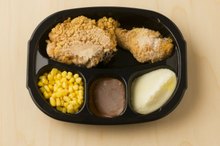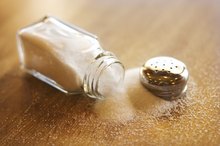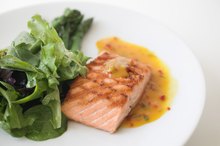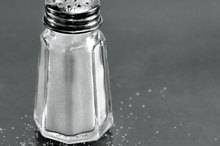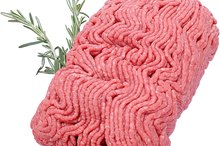What does fact checked mean?
At Healthfully, we strive to deliver objective content that is accurate and up-to-date. Our team periodically reviews articles in order to ensure content quality. The sources cited below consist of evidence from peer-reviewed journals, prominent medical organizations, academic associations, and government data.
The information contained on this site is for informational purposes only, and should not be used as a substitute for the advice of a professional health care provider. Please check with the appropriate physician regarding health questions and concerns. Although we strive to deliver accurate and up-to-date information, no guarantee to that effect is made.
The Sodium Content of Lunch Meat
Lunch meat is a convenient source of protein and an easy ingredient for a quick meal, but its high sodium content may be a hidden danger. A simple luncheon meat sandwich may actually push your sodium intake for the day into levels raising your risk for heart disease and other health problems. Even worse, some people's bodies react more strongly to dietary sodium than others, although there is no way to tell who is vulnerable.
Sodium Recommendations
The 2010 Dietary Guidelines for Americans recommends keeping sodium intake less than 1,500 mg a day for most people, including people with hypertension, diabetes or kidney disease, African-Americans and middle aged or older individuals.. All others should keep their intake below 2,300 mg a day, but keeping it below 1,500 is healthier, even if it isn't necessary 2. According to the Centers for Disease Control and Prevention, Americans older than the age of 2 take in an average 3,436 mg of sodium per day 2. The human body actually needs 180 to 500 mg of sodium each day for proper functioning.
Sodium Dangers
Do Frozen Dinners Have Too Much Sodium?
Learn More
High blood pressure, stroke and heart attack are all linked to high sodium consumption. High blood pressure causes 400,000 deaths a year, according to the CDC. Reducing sodium consumption to levels below 1,500 mg a day may also preserve bone mass, helping to prevent osteoporosis. People who eat less salt also have a lower risk of gastro-esophageal cancer, explains the CDC.
- High blood pressure, stroke and heart attack are all linked to high sodium consumption.
- Reducing sodium consumption to levels below 1,500 mg a day may also preserve bone mass, helping to prevent osteoporosis.
Lunch Meat
Much of the sodium in lunch meat is there as a preservative and food additive. Specifically, sodium nitrate is commonly added to lunch meats to keep bacteria at bay, provide color and texture and hide bitter flavors. Processed foods, such as lunch meat, make up about 70 percent of the salt intake of most people, explains Drugs.com. Some lunch meats are extremely high in sodium. For example, 1 ounce of bologna can contain about 300 mg of sodium and 1 slice of deli ham can contain 350 mg or more of sodium, depending on the curing method and source.
- Much of the sodium in lunch meat is there as a preservative and food additive.
- Specifically, sodium nitrate is commonly added to lunch meats to keep bacteria at bay, provide color and texture and hide bitter flavors.
Considerations
High Sodium Foods List
Learn More
Even luncheon meats labeled as "reduced sodium" or "healthy" may still contribute to your overall sodium intake. The "healthy" label indicates a sodium content less than 480 mg per serving, but a serving may be a single slice of meat. If you put your lunch meat on a sandwich, the bread may contribute up to 300 mg more of sodium, bringing your total consumption during one meal up to almost 800 mg, more than half of the ideal daily intake. The addition of condiments, such as ketchup or mustard, can raise salt levels even more. "Reduced sodium" foods must have 25 percent less sodium than the regular version, but in many cases, this still doesn't bring salt levels down far enough to be considered healthy or safe.
- Even luncheon meats labeled as "reduced sodium" or "healthy" may still contribute to your overall sodium intake.
- Reduced sodium" foods must have 25 percent less sodium than the regular version, but in many cases, this still doesn't bring salt levels down far enough to be considered healthy or safe.
Related Articles
References
- MedlinePlus: Sodium in Diet
- CDC: Americans Consume Too Much Sodium
- Nutrition Action Healthletter: Lunch Meats: The Slice is Right
- Nutrition Action Healthletter: The Sodium Scoreboard
- National Nutrient Database: Bologna, Beef
- U.S. Food & Drug Administration. CFR - Code of Federal Regulations Title 21. Updated April 1, 2018.
- National Institutes of Health. Lower-sodium foods: shopping list. Updated August 22, 2020.
- Clemson Cooperative Extension. HGIC 4061 Nutrient Claims on Food Labels: Extension: Clemson University: South Carolina. http://www.clemson.edu/extension/hgic/food/nutrition/nutrition/dietary_guide/hgic4061.html.
- U.S. Food and Drug Administration. Consumer Information on Reducing Sodium Intake. http://www.fda.gov/Food/IngredientsPackagingLabeling/FoodAdditivesIngredients/ucm253316.htm.
- U. S. Food and Drug Administration. Guidance for Industry: A Food Labeling Guide (9. Appendix A: Definitions of Nutrient Content Claims). http://www.fda.gov/Food/GuidanceRegulation/GuidanceDocumentsRegulatoryInformation/LabelingNutrition/ucm064911.htm
- USDA. Information on Sodium/Salt. https://snaped.fns.usda.gov/nutrition-education-materials/lifestyle-nutrition/myplate-dietary-guidelines-and-general-nutrition
Writer Bio
Bridget Coila specializes in health, nutrition, pregnancy, pet and parenting topics. Her articles have appeared in Oxygen, American Fitness and on various websites. Coila has a Bachelor of Science in cell and molecular biology from the University of Cincinnati and more than 10 years of medical research experience.
